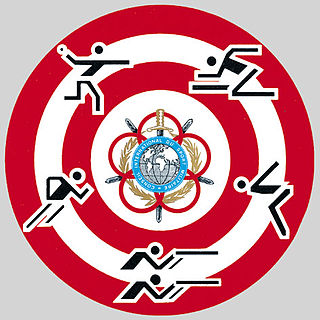Events
Individual competitors or Teams must complete a total of five events consecutively, in the order below. [4] Competitors must wear a helmet, coat, pants with liners, boots, gloves, and a breathing apparatus—an SCBA —during the entire duration of competition. The Challenge is timed from the start of the first event to the end of the fifth event. Competitors must complete the five events within six minutes. Completion times below three minutes are considered excellent. Times below five minutes are acceptable. [4] Since this Challenge is extremely physical, the course director may end a competitor's run if they see the competitor is risking their own health.
Stair Climb with High Rise Pack
The first event is the stair climb. This Challenge consists of a 42 lb. hose which must be carried up six flights of stairs. [4] This activity replicates a five-story building where water is needed at the top. The 42 lb. hose is a standard 100 ft., 1.75 in. thick. hose. The stairwell consists of six sets of stairs, each with ten steps. The firefighter must carry the hose up the stairs and place it in a container box on the top story of the stairwell. The hose may not touch the ground at any point before the firefighter places it in the container box. [5] Once the 42 lb. hose is in the box, the firefighter may proceed with the second event, then descend the stairs, touching each tread and holding on to both handrails on each side of the stairway. On reaching the floor, the firefighter goes onto the next event. Their time is continued and any penalties are added to the final time. Penalties include not touching every step or holding onto the hand rails, which results in a 2-second time addition to their final time per occurrence. The firefighter may also be disqualified if at any time the hose comes off or slides out of the container at the top of the stairway. [5]
Hose Hoist

The second event is the Hose Hoist. Using a hand-over-hand motion, the competitor must pull up a 42-pound (19 kg) hose roll and place it into the box on the top of the 5-story Tower. [4] The 42 lb. prop is a donut roll of large diameter hose (LDH [plus 7 pounds [7.2 kg] of rope). Time continues from the previous event. Loss of control (i.e., allowing the donut to fall more than one story), will result in disqualification.
Forcible Entry

The third event is the forcible entry challenge. This event simulates a firefighter breaking down a door or wall to enter a burning building. The forcible entry simulator used during the Firefighter Combat Challenge is called the KEISER FORCE Machine. [6] In this evolution, the firefighter stands over a 160 lb. beam. They must slam a nine and a half-pound shot mallet into the beam until the beam moves five feet. [4] The firefighter must keep both hands below a tape-marked line on the mallet, and only contact the beam with the head of the mallet. [5] This tape marked line is 1 ft. down from the head of the mallet. The upper edge of the beam is covered with a pressure-sensitive tape that makes contacts other than by the head of the mallet visible. The firefighter receives a warning for the first handle strike. Any hit by the handle afterwards adds five seconds to the final time. Pushing, and raking of the beam is not allowed and is grounds for disqualification. At the first hit, time continues from the previous event. The event is complete once the competitor places the mallet on a 4’ x 3’ mat at the end of the 5 ft. distance. Any part of the mallet must be placed on the mat before the firefighter goes to the next event.
Hose Advance

The fourth event is the hose advance. This simulates a firefighter running from a fire engine towards a close fire. The competitor sprints 140 feet and picks up a 1.75 in. diameter charged (pressurized with water) hose, sprints five more feet with the hose, then drags it an additional 75 feet. [5] Once at the 75 ft line and through the swinging doors, the competitor must then open the hose nozzle, releasing water onto a small target. After hitting the target, they must close the nozzle and drop the hose, which completes the event. [4] The hose nozzle may only be opened once the nozzle opens the swinging doors, if the nozzle is opened earlier a 2-second penalty is added to the final time. If the competitor does not close the nozzle, they must come back close the nozzle and then resume the final event.
Victim Rescue

The fifth and final event is the victim rescue. This event simulates a firefighter removing a victim from a fire as quickly as possible to save the victim from injury. A 175 lb. mannequin must be picked up from the ground, grabbed from behind, and dragged backwards 100 ft. [4] The competitor must drag it backwards at all points of time. The competitor must grab the mannequin from behind with their arms beneath the mannequins arms and around the mannequin's chest. Time ends once the 175 pound mannequin and the competitor passes the 100 ft line. [5] Then competition has ended the Challenge course, and time is stopped.











